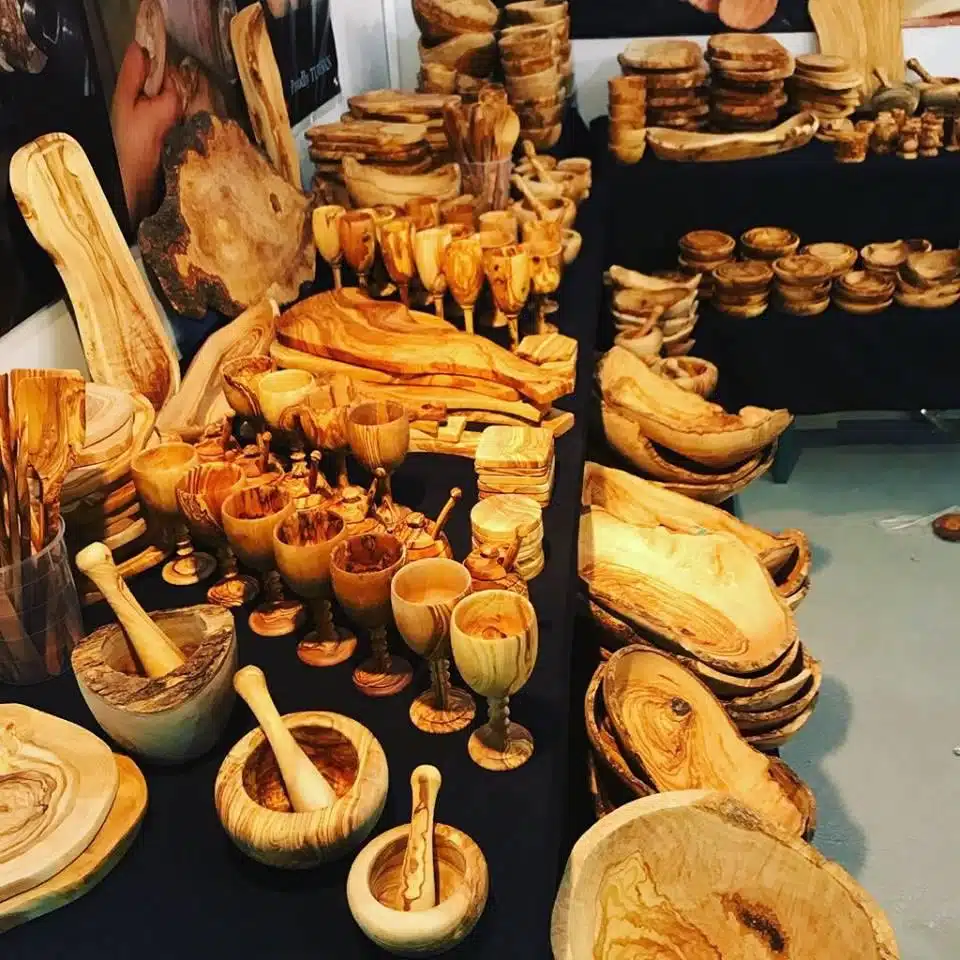Olive Wood Carvings: Sacred Art from the Holy Land

Introduction: Timeless Beauty Carved in Faith
Few art forms capture the essence of history, spirituality, and craftsmanship as powerfully as Olive wood carvings. For centuries, artisans in the Holy Land have transformed the branches of ancient olive trees into sacred works of art. These carvings are more than decorative objects—they are embodiments of faith, cultural heritage, and artistic excellence. At the Jerusalem Art Museum, we celebrate the timeless tradition of olive wood carving, where every piece carries a story of devotion and a connection to the land where faith itself was born.
The Origins of Olive Wood Carving
Ancient Roots in the Holy Land
The olive tree has been a symbol of peace, endurance, and blessing for millennia. Native to the Mediterranean, it has long been revered in biblical texts and Christian tradition. The art of carving olive wood traces back to early Christian pilgrims who visited Jerusalem and Bethlehem. They sought sacred souvenirs, leading local artisans to craft religious figures, rosaries, and crosses from this symbolic wood.
Spiritual Significance of the Olive Tree
In Christianity, the olive tree is deeply tied to spiritual symbolism. It is mentioned in the story of Noah’s Ark, where the dove returned with an olive branch as a sign of peace. In the Garden of Gethsemane, olive trees bore witness to Jesus’ prayers before His crucifixion. These sacred associations make olive wood carvings especially meaningful, transforming each piece into a vessel of faith and devotion.
The Craftsmanship Behind Olive Wood Carvings
Sustainable Harvesting
Artisans in the Holy Land use a sustainable process to craft their works. Rather than cutting down olive trees, which are often centuries old, they harvest pruned branches and trimmings. This ensures that the trees remain preserved while providing the raw material needed for carving.
Traditional Techniques Passed Down Through Generations
The art of olive wood carving is often a family tradition, passed down through generations. Skilled craftsmen use hand tools to shape the wood, carefully polishing and refining it until the natural grain comes alive. This meticulous process highlights the unique textures and warm tones of olive wood, making each carving one of a kind.
The Natural Beauty of Olive Wood
No two olive wood carvings are alike. The wood’s rich golden-brown hues, interwoven with darker veins, create natural patterns that enhance the artistry of every piece. Over time, olive wood develops a deeper luster, making it even more beautiful with age.
Sacred Themes in Olive Wood Carvings
Religious Icons and Figures
Many olive wood carvings depict biblical scenes and figures, from the Nativity to the Last Supper. Statues of Mary, Joseph, and the infant Jesus remain especially popular, serving as devotional items for homes and churches around the world.
Crosses and Rosaries
Crosses made from olive wood are treasured symbols of faith. Often carried by pilgrims, they serve as reminders of the sacrifice of Christ and the enduring strength of Christianity. Rosaries carved from olive wood beads also hold special significance, offering believers a tactile connection to their prayers.
Nativity Scenes
Perhaps the most iconic of all olive wood carvings are Nativity sets. These handcrafted scenes capture the sacred moment of Christ’s birth in Bethlehem, a city still renowned for its skilled olive wood artisans. Each Nativity set, whether simple or elaborate, becomes a centerpiece of spiritual reflection during Christmas.
Olive Wood Carvings as Cultural Heritage
A Bridge Between Past and Present
Olive wood carving is not just about creating religious artifacts—it is a living tradition that connects modern generations to centuries of history. Every carving preserves the memory of ancient faith practices while embracing contemporary artistry.
A Global Symbol of the Holy Land
Because of their deep spiritual meaning, olive wood carvings are often carried far beyond Jerusalem and Bethlehem. Pilgrims, tourists, and collectors bring these works home, spreading the sacred legacy of the Holy Land across the world.
Why Olive Wood Carvings Are Highly Valued
Uniqueness and Authenticity
Each carving is unique due to the natural variations in olive wood grain. Unlike mass-produced items, these handmade works carry authenticity and originality, which add to their spiritual and artistic value.
Durability and Longevity
Olive wood is exceptionally durable, resistant to decay, and capable of lasting for generations. Families often pass down olive wood carvings as cherished heirlooms, ensuring their beauty and meaning endure through time.
A Connection to the Holy Land
Owning an olive wood carving is more than having a decorative object—it is holding a piece of the Holy Land itself. For many, these carvings serve as tangible reminders of their faith journey and spiritual roots.
Olive Wood Carvings at the Jerusalem Art Museum
At the Jerusalem Art Museum, our collection of olive wood carvings highlights both traditional craftsmanship and modern interpretations of this sacred art form. Visitors can explore pieces that range from intricate religious sculptures to contemporary designs inspired by the enduring symbolism of the olive tree.
Through curated exhibits, we aim to honor the artisans who keep this ancient craft alive while educating audiences about the cultural and spiritual significance behind each carving. Our mission is to ensure that olive wood carvings remain celebrated as both sacred treasures and masterpieces of artistic heritage.
Conclusion: Preserving Sacred Art for Generations
Olive wood carvings are far more than works of art—they are vessels of faith, history, and cultural identity. Born from the sacred olive trees of the Holy Land, each carving carries centuries of tradition, spiritual symbolism, and artistic devotion. Whether admired in homes, churches, or museums, they serve as powerful reminders of the enduring bond between faith and artistry.
At the Jerusalem Art Museum, we invite you to discover the timeless beauty of olive wood carvings. By cherishing and supporting this sacred craft, we not only preserve an ancient tradition but also ensure that its message of peace, devotion, and cultural unity continues to inspire generations to come.




